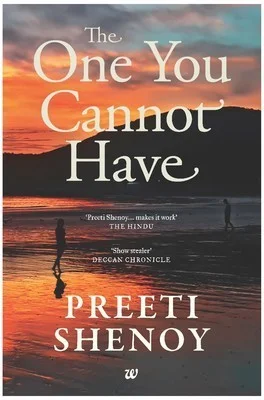Chandigarh, September 21: Preeti Shenoy’s The One You Cannot Have (2013) is a contemporary Indian novel that explores love, heartbreak, second chances, and the ways in which people move forward—or fail to—after failed relationships. Unlike her more motivational or lighthearted works, this novel takes on the weighty subject of emotional healing after betrayal and rejection. It resonates with readers for its relatability, conversational style, and exploration of modern urban relationships in India.
At the heart of the novel is Aman Mathur, a young man in his late twenties who is deeply scarred by his past. Once madly in love with Shruti, his college sweetheart, Aman was left devastated when she abruptly ended their relationship under family pressure and later married another man. This trauma haunts him, leaving him unable to move on or form meaningful connections.
The novel begins with Aman attempting to rebuild his life after this heartbreak. He moves to a new city and takes up a fresh job, but his memories of Shruti weigh him down. He sees her in every corner of his thoughts, and though physically distant, he is emotionally tethered to her. The book vividly portrays Aman’s struggle with depression, insomnia, and the inability to trust again.
Enter Anjali Prabhu, a young woman with a free-spirited and independent personality who joins Aman’s office. Anjali is caring, witty, and sensitive enough to notice Aman’s inner turmoil. She slowly develops feelings for him, but she also recognizes the shadow of Shruti looming large over his heart. For Anjali, the challenge becomes not only loving Aman but also helping him confront his unresolved emotions.
Meanwhile, Shruti’s life is not the happy-ever-after it once appeared to be. Married to Rishabh, a well-meaning but insecure husband, she finds herself in a troubled domestic situation. Rishabh is suspicious of her past, and their marriage suffers from constant tension. Shruti, too, struggles with memories of Aman and often wonders whether she made a mistake by choosing family approval over her own heart.
The novel weaves back and forth between Aman’s efforts to heal and Shruti’s troubled married life. When fate brings them back into each other’s orbit, the old wounds reopen. Shruti tries to reconnect with Aman, hoping to find closure—or perhaps rekindle something—but Aman is torn. For him, Shruti remains “the one you cannot have,” the unattainable love that has defined his life.
As Aman slowly opens up to Anjali, he begins to realize that holding on to Shruti is poisoning his present and preventing him from finding happiness. The tension builds as he must decide whether to stay trapped in the past or embrace a future with someone who genuinely cares for him.
The novel closes on a note of cautious optimism. Aman finally recognizes that love cannot thrive if it is rooted in old wounds. By accepting that Shruti belongs to a different chapter of his life, he begins to give Anjali a chance. While the ending does not promise a fairy-tale resolution, it leaves the reader with the sense that Aman is finally learning to heal and reclaim his life.
The central theme of the novel is how people cope with lost love. Aman embodies the devastation of heartbreak, where memories become shackles. Shruti’s character represents the consequences of choices made under social and familial pressure. The title itself underscores the universal truth that sometimes love remains incomplete, yet life must go on.
The tension between holding onto the past and embracing the future is at the heart of the novel. Aman’s reluctance to move on contrasts with Anjali’s insistence that life is worth living again. Shenoy suggests that second chances are possible, but only when one is brave enough to let go.
Shruti’s unhappy marriage highlights the role of societal pressures in shaping personal decisions. The novel critiques how Indian families often prioritize “suitable matches” over emotional compatibility, showing how such choices can lead to long-term unhappiness.
Mental health, though not explicitly labeled, plays an important role. Aman’s insomnia, mood swings, and inability to focus illustrate the emotional toll of unresolved trauma. The novel resonates with readers who recognize the difficulty of breaking free from painful memories.
Shenoy gives her female characters distinctive voices. Shruti is portrayed as flawed—torn between duty and desire—while Anjali represents resilience and forward-looking optimism. Both women illustrate different ways of navigating love, loss, and societal constraints.
Preeti Shenoy’s hallmark style is simple, conversational prose. She writes in an easy-to-read manner that makes the novel accessible to a wide audience, especially young readers navigating similar emotions. Unlike dense literary fiction, The One You Cannot Have reads quickly, with its alternating perspectives and short chapters sustaining momentum.
Critics and readers have noted that while the book does not break new ground in terms of literary experimentation, its strength lies in emotional relatability. Shenoy captures the rawness of heartbreak without romanticizing it. Many readers have connected with Aman’s paralysis after betrayal and Anjali’s patient attempts to love someone still haunted by the past.
Some critiques, however, point to predictability in the plot and occasional melodrama in the dialogues. The character of Rishabh, Shruti’s husband, sometimes veers toward caricature, as his insecurities seem exaggerated. Nevertheless, for most readers, the emotional truth at the heart of the story outweighs these shortcomings.
The One You Cannot Have succeeds as a heartfelt portrayal of contemporary love and loss. Shenoy does not shy away from showing the messiness of relationships—love is not always a straight path, and sometimes closure is elusive. The novel’s realism is its strength; Aman does not achieve instant healing, and Shruti does not miraculously find happiness. Instead, Shenoy presents a slow, painful journey of acceptance.
The love triangle—Aman, Shruti, Anjali—is handled with sensitivity. Rather than painting Shruti as a villain, Shenoy acknowledges her dilemmas. She made a choice, perhaps a misguided one, but her unhappiness makes her human rather than heartless. Anjali, by contrast, becomes the embodiment of patience and renewal, yet she is not saintly; she struggles with her own doubts about whether Aman will ever truly be hers.
One of the novel’s most powerful aspects is how it reflects the social realities of Indian urban life. Love and marriage remain entangled with family expectations, social standing, and cultural notions of duty. Shenoy portrays how these pressures ripple through lives, often leaving scars that take years to heal.
On the downside, the prose sometimes lapses into over-explanation. Rather than trusting readers to interpret characters’ feelings, Shenoy occasionally spells them out in too much detail. This can make parts of the novel feel simplistic. Still, her straightforward approach is also what makes her writing accessible, especially to readers who are not habitual consumers of heavy literary fiction.
Preeti Shenoy’s The One You Cannot Have is a poignant exploration of heartbreak, healing, and second chances. It resonates with anyone who has struggled to move on from a lost love, while also offering hope that new beginnings are possible. By weaving together Aman’s inner turmoil, Shruti’s regrets, and Anjali’s steady optimism, Shenoy creates a story that feels both personal and universal.
Though not without flaws—occasional predictability and melodrama—the novel succeeds in its emotional honesty. Its enduring popularity lies in its ability to mirror the dilemmas of modern relationships, making readers pause and reflect on their own choices, regrets, and possibilities for renewal.
For those seeking a novel that is both accessible and emotionally engaging, The One You Cannot Have stands out as one of Preeti Shenoy’s most moving works.

